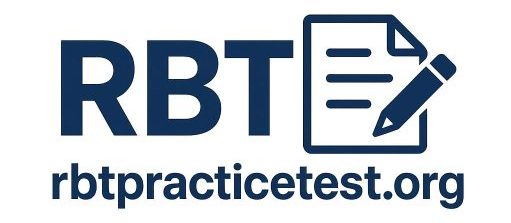This post of our free RBT Exam Study Guide covers Professional Conduct and Scope of Practice, based on Section F of the RBT Task List (2nd Edition). Section F in the RBT exam is critical to both ethical practice and exam success, contributing approximately 11 questions on the certification test.
Section F focuses on the professional expectations for RBTs, including how to interact with supervisors, clients, caregivers, and other professionals in ways that uphold ethical and clinical standards. This guide will walk you through each task under section F, including:
- RBT supervision requirements and roles within the service-delivery model
- How to respond appropriately to feedback and improve performance
- Rules for communicating with stakeholders such as families, teachers, and therapists
- Maintaining professional boundaries and avoiding dual relationships or conflicts of interest
- Treating all clients with dignity, respect, and compassion
- Following all organizational, legal, and ethical regulations related to service delivery
Task F-1: Describe the BACB’s RBT supervision requirements and the role of RBTs in the service-delivery system
RBTs deliver direct ABA services by implementing treatment plans developed by qualified supervisors. Their role focuses on one-on-one instruction, though some also support clients in group settings if appropriately trained.
RBT supervision is a mandatory requirement set by the BACB. To maintain certification, RBTs must receive ongoing supervision from a qualified BCBA, BCBA-D, or BCaBA. This ensures accountability and adherence to the treatment goals established for each client.
Supervision guidelines include:
- Minimum monthly supervision: 5% of total hours providing ABA services
- Observation frequency: At least two face-to-face contacts per month
- One must include a direct observation of the RBT working with a client
- One contact must be individual (not a group session)
Live supervision can occur in-person or via real-time video conferencing platforms (e.g., Zoom, Google Meet). Group supervision (up to 10 RBTs) is permitted, but individual feedback remains essential to maintaining professional standards.
The RBT’s scope of practice does not include developing treatment plans or making clinical decisions. Instead, the RBT:
- Delivers skill acquisition programs
- Implements behavior intervention plans (BIPs)
- Supports data collection and documentation
- Communicates concerns to supervisors promptly
RBTs operate within a tiered service-delivery model, which may include:
- RBTs supervised directly by a BCBA or BCBA-D
- RBTs supervised by a BCaBA, who is in turn supervised by a BCBA or BCBA-D
RBT professional conduct requires all supervision contacts to be documented and co-signed by the RBT and their supervisor each month. Both parties must retain these records for at least seven years for compliance and audit purposes.
If RBTs fail to meet supervision requirements, they risk losing certification. They must self-report shortfalls to the BACB and communicate proactively with their supervisor if supervision hours fall behind.
When not practicing (e.g., between jobs), RBTs are not required to seek supervision. However, extended inactivity should be accompanied by a request for voluntary inactive status to stay in good standing.
Task F-2: Respond appropriately to feedback and maintain or improve performance accordingly
RBTs must respond to supervision feedback with professionalism and a willingness to adapt. Their ability to accept and implement feedback directly affects the quality of ABA services and client progress.
RBTs receive feedback to enhance treatment effectiveness and address performance gaps. Supervisors, typically BCBAs or BCaBAs, provide guidance to ensure that treatment plans are correctly implemented and adjusted based on the client’s needs. These updates may involve changes in instructional methods, data collection strategies, or behavior intervention protocols.
To respond appropriately, behavior technicians should apply the following strategies:
- Listen actively: Focus fully on the feedback without interrupting. Clarify instructions when needed.
- Remain respectful and professional: Accept both praise and constructive criticism without defensiveness.
- Implement changes: Apply all supervisor-recommended adjustments during sessions with consistency.
- Communicate concerns clearly: Ask clarifying questions calmly if a recommendation seems unclear or raises ethical concerns—but always recognize that the supervisor makes final treatment decisions.
- Document updates: Log any modifications made to interventions or procedures as instructed.
Feedback should be ongoing and session-based. Even when no major concerns arise, supervisors may still provide small adjustments or verbal confirmations to support continuity. Many organizations also incorporate formal evaluations through weekly or monthly reviews to reinforce continuous improvement.
Professional conduct for RBTs includes treating feedback as a tool for growth, not judgment. Misinterpreting or resisting feedback can delay treatment progress or violate BACB ethical standards. Consistently applying feedback not only improves session quality but also builds stronger professional trust with supervisors.
Task F-3: Communicate with stakeholders (e.g., family, caregivers, other professionals) as authorized
RBTs may occasionally interact with stakeholders such as parents, caregivers, teachers, or therapists. However, communication must always remain within professional and ethical boundaries.
Stakeholders include anyone involved in the client’s care and treatment. This can range from family members to educational or clinical professionals. The RBT’s role in communication is limited to authorized exchanges, with content restricted to the scope of their training and supervision.
Key guidelines for RBT communication with stakeholders include:
- Only communicate with authorized individuals: Never share client information without documented consent, especially when speaking to individuals outside the immediate family.
- Maintain professional tone and boundaries: Use respectful, concise, and non-clinical language. Avoid providing personal opinions or discussing interventions beyond your training.
- Redirect clinical questions: When stakeholders request recommendations or raise concerns, refer them to the supervising BCBA. For example, say:
“That’s a great question for [BCBA name]. I’ll pass it along to them for follow-up.”
RBTs do not have the authority to make treatment decisions or suggest changes to intervention plans. Doing so may violate BACB guidelines and fall outside the scope of practice for behavior technicians. All feedback and decisions must come from the supervising BCBA or BCaBA.
While RBTs may occasionally attend team meetings (e.g., IEP meetings in schools), their role is to report observations and share updates on session implementation, not to interpret data or recommend new strategies. Any formal communication or decision-making must be handled by the supervisor.
This intersection between clinical communication and proper documentation is also emphasized in the documentation and reporting section of RBT study guide, which outlines the responsibilities of reporting, data tracking, and maintaining ethical communication standards.
Task F-4: Maintain professional boundaries (e.g., avoid dual relationships, conflicts of interest, social media contacts)
RBTs must maintain strict professional boundaries to protect the therapeutic relationship and ensure objective care. Their role is to deliver behavior-analytic services without personal involvement that could interfere with treatment outcomes.
Professional boundaries are essential for ethical and effective ABA therapy. The RBT Ethics Code requires technicians to separate personal relationships from clinical responsibilities to prevent bias, loss of objectivity, or conflicts of interest.
To stay within the scope of professional conduct, RBTs must avoid:
- Dual relationships, such as being a friend, family member, or coworker of the client or caregiver
- Personal interactions outside of therapy, including attending family events or babysitting
- Exchanging contact information like personal phone numbers or connecting on social media
- Deep personal disclosures, especially when they go beyond maintaining a respectful, professional tone
A dual relationship occurs when an RBT holds any role other than service provider to the client or their family. For example, if an RBT is friends with a client’s parent or related to a client, this creates a conflict that could compromise treatment integrity.
Additional examples of boundary violations include:
- Spending time with clients outside of sessions
- Working a second job alongside a client’s caregiver
- Being Facebook or Instagram friends with any client or family member
- Regularly giving or receiving gifts exceeding $10 in value
RBT professional conduct requires therapists to avoid these situations entirely. If unavoidable, such as in rural communities, extra steps must be taken to reinforce boundaries, including clear communication and supervisor involvement.
Should a situation arise where a boundary may be crossed, the RBT must:
- Immediately notify their supervisor
- Document the concern and work with the supervisor to establish corrective actions
- Withdraw from the case if the conflict cannot be resolved without compromising care
Once the therapeutic relationship ends, RBTs may form personal relationships only if they avoid romantic or sexual involvement for at least two years, per BACB ethical standards.
Task F-5: Maintain client dignity
RBTs must treat clients with dignity by showing consistent respect, empathy, and professionalism. This core value ensures that individuals receiving services feel valued, safe, and heard throughout the therapeutic process.
Client dignity is the foundation of ethical ABA service delivery. It means recognizing the worth of each client regardless of ability, background, or behavior. RBTs must actively protect this dignity in every interaction—through language, conduct, and professional intent.
To maintain client dignity, RBTs should:
- Speak respectfully: Avoid belittling, sarcasm, or overly casual language
- Treat clients as individuals, not as cases, diagnoses, or problems
- Honor privacy and confidentiality, especially during data collection or stakeholder communication
- Remain focused on the client during session time—limit side conversations or distractions
The principle of professional conduct and scope of practice for RBTs includes setting aside personal judgments. For instance, if an RBT disagrees with a caregiver’s lifestyle or habits, that personal bias must never interfere with the delivery of care.
RBTs also uphold dignity by:
- Encouraging client autonomy and communication, even if it’s limited or emerging
- Respecting assent and withdrawal of assent, especially when clients display discomfort
- Being aware of cultural, religious, and family values when implementing interventions
- Using positive reinforcement as a central method of teaching and behavior change
RBTs must extend to stakeholder interactions by communicating with families and professionals, reflecting the client’s values and rights.
Maintaining these day-to-day professional standards is only one part of long-term ethical practice, RBTs also uphold these responsibilities throughout their certification lifecycle. As part of ongoing credentialing, RBTs are expected to maintain compliance with the BACB ethics code across all service settings.
One of the key elements emphasized in maintaining your certification is completing ethics-related training as part of the RBT certification renewal process. This helps ensure that professional conduct remains current, consistent, and aligned with evolving best practices in the ABA field.
How to practice RBT Professional Conduct and Scope questions?
To reinforce your understanding of the concepts covered in this section, make sure to check out our RBT Exam – Practice Test Section F. This section-wise test is designed to help you apply what you’ve learned, identify knowledge gaps, and prepare confidently for the RBT exam.
If you want to really understand professional conduct and scope of practice, it’s helpful to practice with questions like you’ll see on the real test. Our free RBT Practice Test covers all the important topics and lets you see how ready you are. Try it out now to build confidence and find out what you still need to review!

